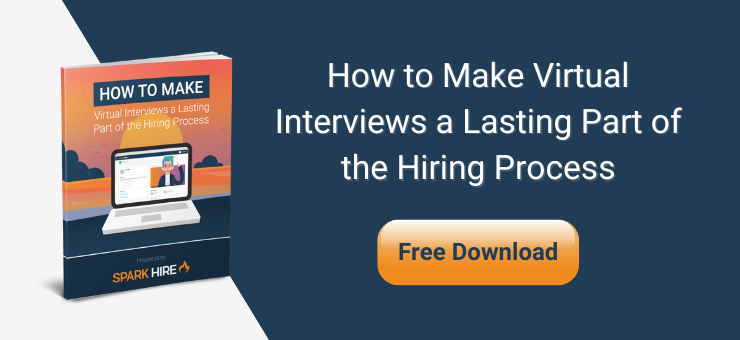Doing anything too quickly is believed to lead to costly mistakes and often, it does – unless it is done correctly. This is one reason why reducing your time to hire doesn’t guarantee better hiring outcomes.
The good news is, fast and effective is possible. You can even improve quality of hire by picking up the pace.
The bottom line is you need to be able to funnel high-quality talent through your hiring process quickly without cutting corners on candidate assessment and team collaboration. Boosting your hiring velocity, or speed to hire, can improve quality of hire.
What does this mean for critical hiring metrics? You could see higher performance, productivity, team morale, employee engagement, and lower retention – and get more bang for your hiring buck.
Here are a few ways hiring faster the right way can improve quality of hire:
Filtering non-serious candidates out early
Candidates apply to multiple roles at one time. Application processes through job search sites like LinkedIn and Indeed have made it possible for talent to apply for open roles quickly without carefully vetting the requirements or company. In fact, candidates are recommended to apply to two to three jobs online daily.
This means dozens of candidates who apply to your empty roles may not be qualified.
With a traditional hiring model, once you review countless resumes, you scour your calendar for empty spots to schedule phone interviews. Sending out one-way video interview invitations to applicants who meet the basic qualifications instead allows candidates to self-filter.
How is that possible? Only serious candidates are likely to submit completed videos.
Your team doesn’t waste time on phone screens with candidates who would not likely complete the interview process or earn an offer. Even better, while competitors are still making phone calls, you could have video interviews from top candidates in your inbox. It’s widely accepted that the best candidates are off the market in as little as 10 days, so you need to be quick in the early stages of hiring to catch and keep them in your funnel.
Screen more qualified candidates
The speed and efficiency of your hiring process set the parameters for how many candidates you can reasonably consider for each open role. You have to factor in the bandwidth of your total resources, including staffing, scheduling, and hiring tools.
On average, recruiters can have anywhere from 30-40 open requisitions at one time. Ideally, recruiters want to move as many qualified candidates as possible into the hiring process, but at 118 applicants a job, they are in for a packed screening schedule. Reviewing resumes and calling up candidates can take weeks to fill a single role.
To save time, it’s logical to move the first 20 candidates who fit the job requirements on to hiring managers – but what if the best-fitting talent was in the top 40? If only recruiters had time to screen more candidates early in the process.
Your company could be missing out on the best candidates and reducing your overall talent pool by sticking with antiquated interview models. By updating hiring technology with video interview software, scheduling tools, and effective team collaboration solutions, there’s no excuse for passing up top-quality candidates. Not when one hiring or recruiting professional can screen up to 5x more applicants.
Identifying top candidates in the earliest screening stage
Creating a strategy to effectively speed up your early screening process includes improving the accuracy of your initial interviews. The goal is to ensure your team identifies the highest qualified candidates before bringing talent in for in-person interviews.
This often influences hiring teams to subject candidates to a barrage of AI personality tests, skills tests, and other assessments after reviewing their applications. The problem is, 58% of candidates expect to hear back after their application in one week or less according to a survey by Greenhouse.
Most candidates aren’t willing to wait around for the results of your complicated hiring assessments. They want to connect with interviewers sooner.
Being able to filter and catch the top candidates faster means you advance high-quality talent into your interview process before they get grabbed by competitors. You can access the critical insights you need in the initial screening process through the use of your one-way video interviews.
Even better, candidates feel like they are getting an opportunity to explain their merit and showcase their personality directly to a recruiter or a hiring manager – something a resume simply can’t do.
When asked “What is one thing you wish organizations and HR professionals understood better about the hiring experience from the perspective of a job/work candidate?” in a recent Sterling survey, candidates replied, “Understand the applicant’s true abilities and potential.”
Candidates want to share their personal attributes and skills with real people rather than feel as though they are disqualified by a machine or words on a piece of paper. Giving them this opportunity from step one of the hiring process makes a strong impression on highly qualified candidates.
Plus, you get an accurate assessment of their true abilities and potential that you can conveniently share with peers for feedback before advancing top candidates.
Improving interview completion rates
Because candidates apply for several positions a day and expect a fast recruiter response and hiring process, they could drop out at any stage of the interview process.
Any amount of time your team spends vetting candidates to that point is wasted – not to mention the money drained from your hiring budget to replace them by interviewing more candidates. The alternative is to advance lesser-quality candidates lingering in your hiring process.
An alarming 26% of candidates in Sterling’s report dropped out of their most recent hiring experience – nearly half of respondents said they considered dropping out. The No. 1 factor that influenced these candidates was time to hire.
Scheduling conflicts, redundant interviews, and excessive screening tests complicate the hiring process and can devastate your speed to hire. There seems to be a gap between HR professionals and candidates when it comes to complex and taxing hiring experiences.
The majority (91%) of HR professionals don’t believe candidates would find their hiring process complicated, but according to Sterling data, more than a third of candidates have dropped out because the hiring process was too complicated.
What does it mean? You could be losing top contenders and be left with less qualified candidates who advance due to inefficient screening. That’s right, you may be trying to improve quality of hire, but hurting your hiring velocity in the process.
Moving forward fast enough to improve interview completion rates ensures all qualified candidates are likely to finish the evaluation process. This means your offers are extended to the true ‘best’ candidate for the job.
Streamlining interview evaluation and collaboration
Finding ways to streamline your hiring process should never mean cutting corners on your evaluation/collaboration among hiring team members. Instead, opting for innovative interview tools and a structured interview process encourages more key stakeholders to offer valuable feedback in less time.
Better informed hiring decisions are made in the process, leading to better quality hires. Video interviews make it possible for everyone necessary to weigh in without inconveniencing their schedules or slowing down hiring decisions.
There are a few ways implementing video interview software into your hiring strategy contributes to improved quality of hire, while speeding up collaboration. First, let’s look at how you should be measuring the quality of hire.
Quality of Hire = (employee performance + employee fit + manager satisfaction)/3
Employee performance is a key factor, but employee fit is essential to their satisfaction in their role as well as their engagement with team members, and ability to collaborate and connect with the culture. Finally, manager satisfaction is a critical consideration. Making a poor hiring decision can hugely impact the whole team’s workplace experience.
Reduced influence of unconscious bias
While we may not like to acknowledge they exist, unconscious biases can creep into the hiring process at any time. Collaboration in the hiring process invites different perspectives that can help weed out bias. Sharing video interviews makes it possible for everyone to review, rate, and share feedback on the same responses.
Screening for culture fit and culture add
How well a candidate fits into the culture has a major impact on their sense of belonging in the company. Identifying what they add to the team dynamics and skills is essential to team growth. It may be necessary to have a few different perspectives for this evaluation, especially if two candidates are nearly equally matched in other ways.
Evaluating soft and hard skills
Different skills contribute to a candidate’s success in different roles. Hard skills can be easier to measure than soft skills, and they are often easier to teach. Getting several people to weigh in on candidate assessments can help your team identify talent with the most significant skills for your open role and team.
Improving manager satisfaction
Hiring a less experienced or qualified candidate can put extra pressure on team members, especially managers. How quickly a new hire gets up to full performance and integrates with their team impacts a manager’s experience and ability to lead their team.
When you improve quality of hire, you reduce stress on your team. It’s important to allow managers to review and provide feedback on candidates with a fast and efficient hiring solution. This alleviates some of their workloads while ensuring they contribute to the best hiring decisions for their team.
Getting to the offer stage ahead of the competition
It’s a candidate’s market (even when it’s not). Since the Great Resignation, candidate expectations have been higher than ever. And when unemployment is low, most candidates who apply to your jobs are only passively looking for career changes.
These busy candidates casually apply to multiple positions and many will take the first ‘best’ offer to advance their careers. A faster hiring process means you can get top talent to the offer stage and secure high-quality talent before they land another job.
What’s more, data from NACE shows the current application to offer rate is 42% and the current offer acceptance rate is just 66%. This means less than half of the candidates who apply to your open roles are qualified enough to make it to the offer stage. And once you extend your offer, ⅓ of candidates are likely to reject it.
Not surprisingly, nearly 10% of candidates in Sterling’s survey who dropped out of their most recent hiring experience said it was due to receiving and accepting another job offer. It all bottles down to the speed by which you get high-quality talent through your hiring process and extend an offer. Calculated enhancements to speed can improve quality of hire. Period.
Adopting a faster and more efficient hiring process mitigates the risk of losing top candidates before they advance to the offer stage. By implementing innovative hiring practices and tools, like video interview software and structured interviews, you maximize your hiring velocity – filling empty seats with the highest-quality hires when and where you need them.












